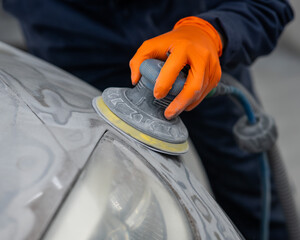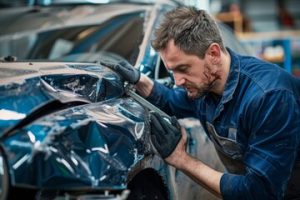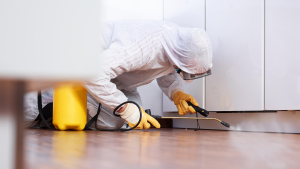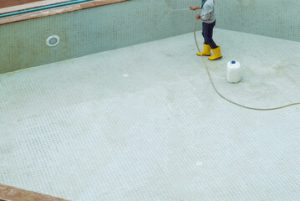A car’s paint can drastically affect its appearance and value. A detailed restoration of the paint can make your vehicle look new again and increase its resale value.

Paint correction is a lengthy process that requires talent, expertise and proper tools. This includes decontaminating the surface, assessing the paint and choosing the correct materials for the job at hand. Keep reading the article below to learn more about Auto Paint Restoration.
The paint on your car takes a beating from the elements. It is exposed to sun damage which causes it to fade and also abrasions from abrasive road debris and other contaminants. It is important to keep your car’s paint in good condition as it plays a significant role in the car’s visual appeal and resale value.
Having your car’s paint restored can make it look new again and will increase the value of the vehicle at resale. It can be done in a number of different ways, including buffing and waxing.
Before deciding on the best option for your vehicle, it is a good idea to wash it thoroughly to remove dirt and other contaminants. This will help to prevent the paint from scratching while you buff it. Afterwards, you can apply quality wax or sealant to the entire body of the vehicle to protect it from UV rays and soil.
In some cases, a car paint restoration may be all that is needed to restore it to its original luster and finish. However, some damage may require deeper paint correction and even repainting. It is a process that requires talent, expertise and suitable tools.
The process of paint correction involves using an electric polisher, specialized buffing compounds and pads to eliminate scratches and dullness on the vehicle’s surface. It will also address oxidation fading and etching. A thorough paint correction will give your car a beautiful appearance while improving its durability and protection.
During this procedure, the vehicle will be decontaminated, and then it will be buffed with specific compounds and pads in stages. The first stage uses a more abrasive pad and cutting polish to remove oxidation and scratches from the paint. The second stage uses a less abrasive pad and a finer polish to refine the paint and enhance glossiness. Finally, a coat of wax or a ceramic coating is applied to protect the freshly polished and refined paint.
Faded paint is a common issue that can be fixed without having to repaint the entire car. The most important thing to do is wash the car thoroughly, then dry it with a microfiber towel. It is also a good idea to take precautions against further sun damage, such as keeping the car in a garage or under a carport or by covering it with a cover when not driving it.
Ceramic Coating
Ceramic coating is a paint protection product that is gaining popularity in the automotive detailing industry. It creates a hydrophobic layer over the vehicle’s surface, repelling dirt, mud, and water. Ceramic coating also protects the car’s finish from fading and UV damage. This is a great option for Rexford car owners who want to improve the appearance of their vehicle and protect it from contaminates. Before applying a ceramic coat, it is important to perform a thorough paint correction. This process involves using polishing compounds and machine polishers to produce a smooth, swirl free surface. It also removes contaminates and restores the depth, gloss, and shine of the vehicle’s original paint job.
After the paint correction, it is essential to clean and dry the surface before applying the ceramic coating. This step is very important because if any contaminants are left on the surface, they will cause the ceramic coat to bond poorly. In addition, it is recommended to use a clay bar to eliminate any contaminates and prepare the paint for the application of a ceramic coating. Once the surface is clean, it is best to work in a shaded area with a microfiber cloth dampened with isopropyl alcohol.
There are several consumer-grade ceramic coating products on the market that are inexpensive and easy to apply at home. However, these products typically have lower SiO2 percentages and don’t provide the same longevity as professional-grade products.
Most ceramic coatings require a curing period that can range from a few hours to a day. During this time, the vehicle should be covered or kept indoors to prevent water spots and stains. It is also important to avoid washing the vehicle or exposing it to contaminants until the coating has fully cured.
While a ceramic coating is an excellent option for Rexford car owners, it is not a substitute for regular car washing. Keeping up with the maintenance of your vehicle and using pH-neutral car wash products will ensure that the ceramic coating lasts and continues to protect the vehicle’s finish. If you are considering getting a ceramic coating, it is best to consult a professional detailer who has experience with this type of product.
Repairing Scratches
Scratches on your car are a normal part of vehicle ownership, and although they may seem permanent, they don’t have to be. With the right tools, products and technique, they can be repaired to look almost invisible. This will preserve your car’s paint and reclaim its showroom shine.
While some scratches can be addressed with a scratch removal product and rubbing with a microfiber cloth, deep damage often necessitates professional help. Understanding when to call in the pros will save time, money and prevent further damage.
How damaging a scratch is depends on how many layers of paint it penetrates through. A quick test is to run your fingernail across the mark. If it doesn’t catch, then the scratch only damaged the clear topcoat and may be able to be corrected with some sanding and polishing. However, if it goes through the clear coat and base coat to reveal bare metal, it’s time for professional help.
To repair a shallow scratch, a kit available at auto parts stores typically includes a sanding compound and a buffing pad. Start by sanding the area gently with a sandpaper grit that is slightly finer than your vehicle’s original finish. Continue sanding until the scratch begins to level with the surrounding paint, then switch to a finer grit. Once the sanding is complete, apply the rubbing compound to the affected area and buff it until the scratch disappears. Rinse and wipe the area clean, then apply a sealant to protect the repairs from Wear-and-Tear.
More serious paint scratches that go through the base coat and into the enamel color layer require a more extensive repair strategy. This can involve sanding, priming and painting, which can be a complicated process that’s better left to professionals.
When a scratch goes all the way through the layers of your car’s paintwork to expose bare metal, it must be treated immediately to prevent rust and other damage. This can only be done by a professional who will use an auto body shop and have access to specialized equipment. A touch-up paint pen is an easy way to repair a small area of damage, but it will need to be carefully matched to the vehicle’s original color code to avoid looking patchy.
Restoring Color
Car paint is not just a cosmetic element, it is designed to protect the metal body from corrosion and other environmental hazards. Unfortunately, over time your vehicle’s paint can become dull and faded due to a number of factors. The most common reason for fading is sun exposure but other causes include dirt, pollution, scratches and more.
Fortunately, even very faded paint can be restored with professional Auto Paint Restoration. This process involves buffing the paint with specific compounds and pads to bring back the shine. The first step is to wash the car thoroughly to remove loose dirt and debris. Then a clay bar is used to remove embedded contaminants that washing alone can’t. Then it is time to start polishing. A dual-action or rotary polisher with a high-quality buffing compound will help to remove the oxidation and other imperfections. Darker colours may require a more aggressive rubbing compound to get them looking good again. After the paint is looking glossy and new, a ceramic coating or wax will be applied to protect it from further damage.
The results of Auto Paint Restoration are amazing and can take your vehicle’s paint job to a whole new level. However, this is a process that requires skill and the right tools to be successful. It is best left to the professionals who have the experience and know how to use the right compounds and pads to achieve the desired result.
If you are interested in having your faded car’s paint restored, give us a call or send an email and we will be happy to give you a quote. We also recommend having a ClearPro Paint Protection Film installed after the paint restoration to keep your vehicle safe from the elements and future damage.
Faded car paint can look really bad and can make the car seem ugly. Fortunately, the faded paint is usually just the clear coat which can be brought back to its original gloss and color with professional Auto Paint Restoration. This is a longer process than just simple polishing and involves decontaminating the surface, assessing the condition, choosing proper materials and then actually doing the correction work.




